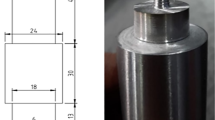Abstract
This paper presents a new two-pass friction stir welding (FSW) implementation called parallel friction stir welding (P-FSW). This process is classified into two categories: Advanced parallel friction stir welding (AP-FSW) and retreating parallel friction stir welding (RP-FSW). The effects of three parameters named the type of process, tool offset in first pass, and tool offset in the second pass on tensile strength of AA6061-T6 and AA7075-T6 joint in FSW have been investigated experimentally. To design experiments, optimization, and analyzing the results, response surface methodology (RSM) has been used. Quantitative and qualitative variables have been considered in five and two levels, respectively. Based on obtained results, it has been observed that tool offset in the second pass, type of process, and tool offset in the first pass have the most effect on tensile strength of welded joint, respectively. In both AP-FSW and RP-FSW processes, the maximum tensile strength occurred at the maximum value of tool offset in the second pass and minimum value of tool offset in the first pass. The maximum joint efficiency of AP-FSW and RP-FSW processes with respect to AA6061-T6 were obtained 83.1% and 95.4%, respectively.












Similar content being viewed by others
Data availability
All data analyzed during this study are available from the corresponding author on request.
References
Devaiah D, Kishore K, Laxminarayana P (2018) Optimal FSW process parameters for dissimilar aluminium alloys (AA5083 and AA6061) Using Taguchi Technique. Mater Today: Proc 5(2):4607–4614
Mishra RS, De PS, Kumar N (2014) Friction stir welding and processing: science and engineering. Springer
Schmidt H, Hattel J, Wert J (2003) An analytical model for the heat generation in friction stir welding. Modell Simul Mater Sci Eng 12(1):143
Akbari M, Aliha M, Keshavarz S, Bonyadi A (2019) Effect of tool parameters on mechanical properties, temperature, and force generation during FSW. Proc Instit Mech Eng Part L: J Mater: Des Appl 233(6):1033–1043
Aziz SB, Dewan MW, Huggett DJ, Wahab MA, Okeil AM, Liao TW (2016) Impact of friction stir welding (FSW) process parameters on thermal modeling and heat generation of aluminum alloy joints. Acta Metall Sin (Engl Lett) 29(9):869–883
Meyghani B, Awang M, Emamian S, Nor MKBM (2019) Thermal modelling of friction stir welding (FSW) using calculated Young’s modulus values, in The advances in joining technology. Springer, pp 1–13
Zhao Z, Liang H, Zhao Y, Yan K (2018) Effect of exchanging advancing and retreating side materials on mechanical properties and electrochemical corrosion resistance of dissimilar 6013-T4 and 7003 aluminum alloys FSW joints. J Mater Eng Perform 27(4):1777–1783
Ramachandran K, Murugan N, Kumar SS (2015) Effect of tool axis offset and geometry of tool pin profile on the characteristics of friction stir welded dissimilar joints of aluminum alloy AA5052 and HSLA steel. Mater Sci Eng A 639:219–233
Naghibi HD, Shakeri M, Hosseinzadeh M (2016) Neural network and genetic algorithm based modeling and optimization of tensile properties in FSW of AA 5052 to AISI 304 dissimilar joints. Trans Indian Inst Metals 69(4):891–900
Sahu PK, Pal S, Pal SK, Jain R (2016) Influence of plate position, tool offset and tool rotational speed on mechanical properties and microstructures of dissimilar Al/Cu friction stir welding joints. J Mater Process Technol 235:55–67
Kar A, Suwas S, Kailas SV (2019) Significance of tool offset and copper interlayer during friction stir welding of aluminum to titanium. Int J Adv Manuf Technol 100(1-4):435–443
Mastanaiah P, Sharma A, Reddy GM (2016) Dissimilar friction stir welds in AA2219-AA5083 aluminium alloys: effect of process parameters on material inter-mixing, defect formation, and mechanical properties. Trans Indian Inst Metals 69(7):1397–1415
Tamjidy M, Baharudin B, Paslar S, Matori K, Sulaiman S, Fadaeifard F (2017) Multi-objective optimization of friction stir welding process parameters of AA6061-T6 and AA7075-T6 using a biogeography based optimization algorithm. Materials 10(5):533
Liu H, Li J, Duan W (2013) Research on reverse dual rotation friction stir welding process. In: Proceedings of the 1st International Joint Symposium on Joining and Welding. Elsevier, pp. 25–32
Li J, Liu H (2013) Characteristics of the reverse dual-rotation friction stir welding conducted on 2219-T6 aluminum alloy. Mater Des 45:148–154
Li J, Liu H (2015) Effects of the reversely rotating assisted shoulder on microstructures during the reverse dual-rotation friction stir welding. J Mater Sci Technol 31(4):375–383
Shi L, Wu C, Liu H (2015) The effect of the welding parameters and tool size on the thermal process and tool torque in reverse dual-rotation friction stir welding. Int J Mach Tools Manuf 91:1–11
Thomas W, Staines D, Watts E, Norris I (2005) The simultaneous use of two or more friction stir welding tools, vol 13. TWI published on the Internet, Abington
Liu H-j, Zhang H-j (2009) Repair welding process of friction stir welding groove defect. Trans Nonferrous Metals Soc China 19(3):563–567
Kumari K, Pal SK, Singh SB (2015) Friction stir welding by using counter-rotating twin tool. J Mater Process Technol 215:132–141
Jain R, Kumari K, Pal SK, Singh SB (2018) Counter rotating twin-tool system in friction stir welding process: a simulation study. J Mater Process Technol 255:121–128
Totten GE (2006) Steel Heat Treatment Handbook, -2 Volume Set. CRC press
A. Standard, E8/E8M (2009) Standard test methods for tension testing of metallic materials. ASTM international, West Conshohocken. https://doi.org/10.1520/E0008-E0008M-09www.astm.org
Author information
Authors and Affiliations
Contributions
The authors read and corrected the manuscript. All authors read and approved the final manuscript.
Corresponding author
Ethics declarations
Competing interests
The authors declare that they have no competing interests.
Additional information
Publisher’s note
Springer Nature remains neutral with regard to jurisdictional claims in published maps and institutional affiliations.
Recommended for publication by Commission III - Resistance Welding, Solid State Welding, and Allied Joining Process
Rights and permissions
About this article
Cite this article
Ghiasvand, A., Hassanifard, S., Jalilian, M.M. et al. Investigation of tool offset on mechanical properties of dissimilar AA6061-T6 and AA7075-T6 joint in parallel FSW process. Weld World 65, 441–450 (2021). https://doi.org/10.1007/s40194-020-01037-4
Received:
Accepted:
Published:
Issue Date:
DOI: https://doi.org/10.1007/s40194-020-01037-4




